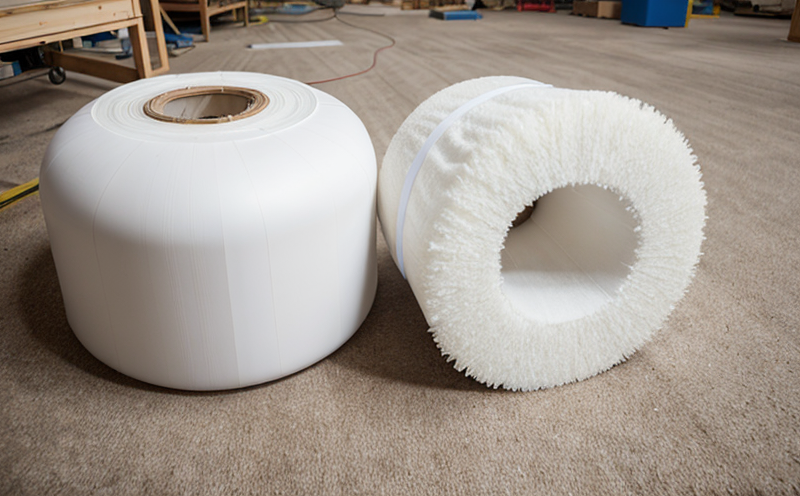ISO 9053 Airflow Resistance of Acoustic Materials Testing
The ISO 9053 standard provides a method to determine the airflow resistance of acoustic materials, which is crucial for evaluating their performance in sound insulation and noise reduction applications. This service is particularly important for industries such as construction, automotive, and consumer electronics where the quality and effectiveness of acoustic materials play a significant role.
The testing involves measuring the pressure drop across the material sample when air flows through it under controlled conditions. The results help in assessing how well the material can reduce sound transmission between two spaces. This is essential for ensuring that products meet regulatory standards and perform as expected in real-world environments.
For accurate and reliable testing, we follow strict protocols outlined in ISO 9053. Specimens are carefully prepared according to standard guidelines, ensuring consistency across all tests. The instrumentation used includes precision manifolds and pressure sensors that provide precise measurements of airflow resistance. Our experienced technicians ensure that each test is conducted under controlled environmental conditions to minimize variables.
The process begins with selecting the appropriate specimen size for testing based on the material's intended use. Samples are then mounted in a specially designed apparatus where they undergo pressurization and airflow measurement. The data collected is analyzed using advanced software tools that generate comprehensive reports detailing the test results.
These reports include key parameters such as the resistance coefficient (R'), which quantifies the material's ability to resist air flow, and the equivalent sound absorption coefficient at various frequencies. Understanding these metrics helps in optimizing the design of acoustic materials for specific applications like soundproofing walls or automotive interiors.
In addition to meeting quality control requirements, ISO 9053 testing also supports product development by providing insights into material performance under different conditions. This information is invaluable for R&D teams looking to innovate and improve existing products or develop new ones that meet evolving market demands.
Our comprehensive approach ensures not only compliance with international standards but also enhances the overall quality of acoustic materials used in various sectors. By offering this service, we contribute significantly to maintaining high standards across industries relying heavily on effective noise management solutions.
Industry Applications
- Construction: Ensuring that walls and floors meet sound insulation requirements.
- Automotive: Evaluating interior materials for optimal noise reduction within vehicles.
- Consumer Electronics: Testing components used in speakers or headphones to ensure proper sound transmission.
The results from ISO 9053 tests are vital across these sectors, helping manufacturers achieve regulatory compliance while enhancing the comfort and safety of end-users. In construction projects, for instance, accurate airflow resistance data can help architects and builders select materials that effectively reduce noise levels between rooms or floors.
For automotive manufacturers, understanding how different interior materials behave under pressure ensures better integration into vehicle designs aimed at reducing cabin noise without compromising structural integrity. Similarly, in the consumer electronics industry, precise measurements aid in creating products that deliver clear audio without unnecessary background noise interference.
International Acceptance and Recognition
- ISO 9053 is widely adopted by countries around the world as it offers a standardized approach to testing acoustic materials.
- This standardization ensures that results from one country can be compared accurately with those from another, promoting global consistency in product quality and performance.
The acceptance of ISO 9053 extends beyond mere compliance; it fosters trust among stakeholders by providing a reliable method for evaluating acoustic materials. Companies operating internationally benefit greatly from adhering to this standard since it allows them to meet local regulations while maintaining consistent quality standards regardless of location.
Moreover, international acceptance enhances the reputation of companies that demonstrate their commitment to high-quality products through rigorous testing procedures like those prescribed in ISO 9053. This recognition can lead to increased market share and customer satisfaction as consumers become more confident about purchasing materials proven effective by this globally recognized standard.
Environmental and Sustainability Contributions
Evaluating the airflow resistance of acoustic materials through ISO 9053 testing plays a crucial role in promoting environmental sustainability. By ensuring that these materials perform optimally, industries can minimize energy consumption associated with heating or cooling spaces where sound insulation is needed.
For instance, in residential buildings, properly insulated walls and floors can significantly reduce the need for HVAC systems to work harder to maintain comfortable temperatures. This not only saves on electricity costs but also reduces greenhouse gas emissions by decreasing reliance on fossil fuel-based energy sources.
In commercial settings like offices or hospitals, effective acoustic materials help create more comfortable working environments that promote productivity and well-being among occupants. Additionally, by selecting sustainable options for these materials during construction or renovation projects, companies contribute positively towards reducing the carbon footprint of built structures.





